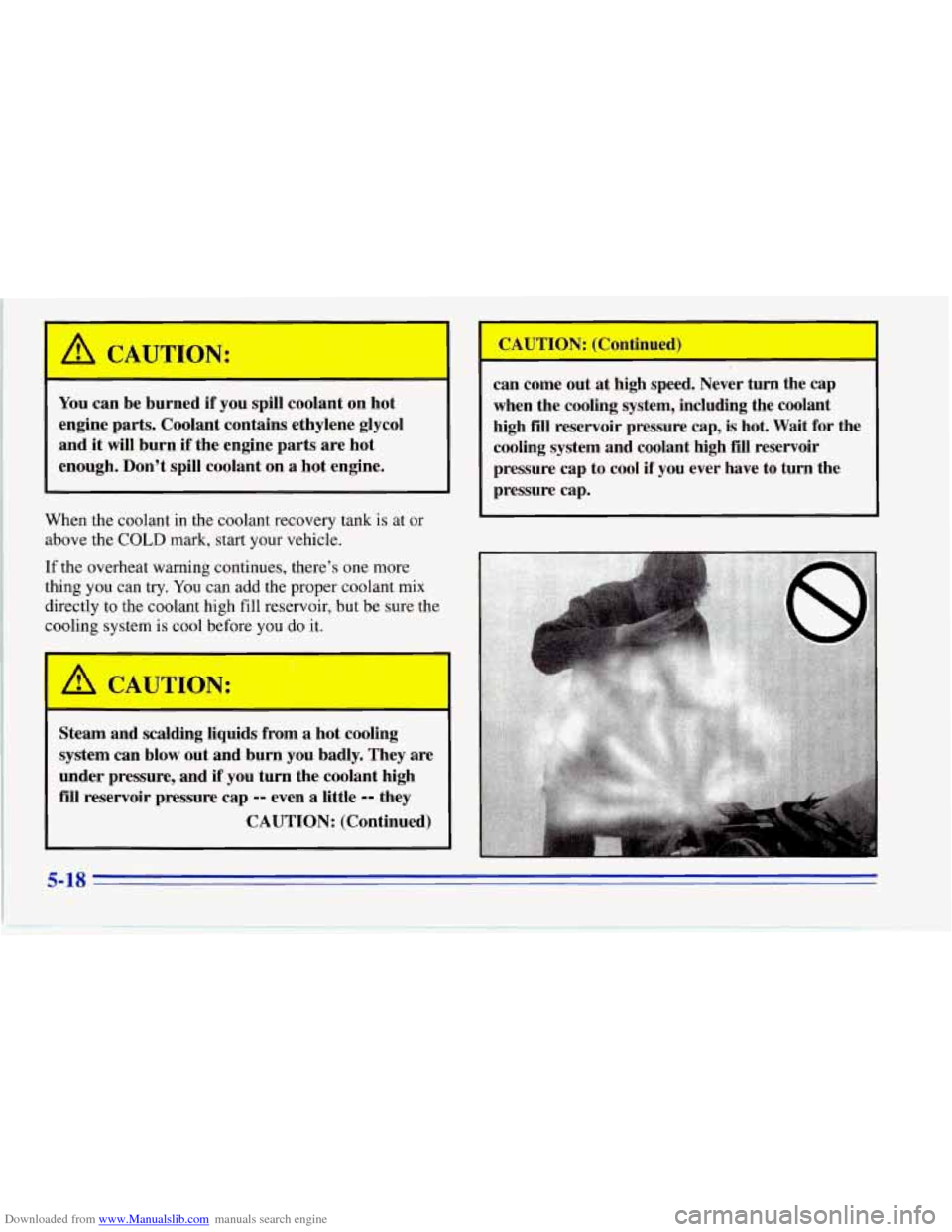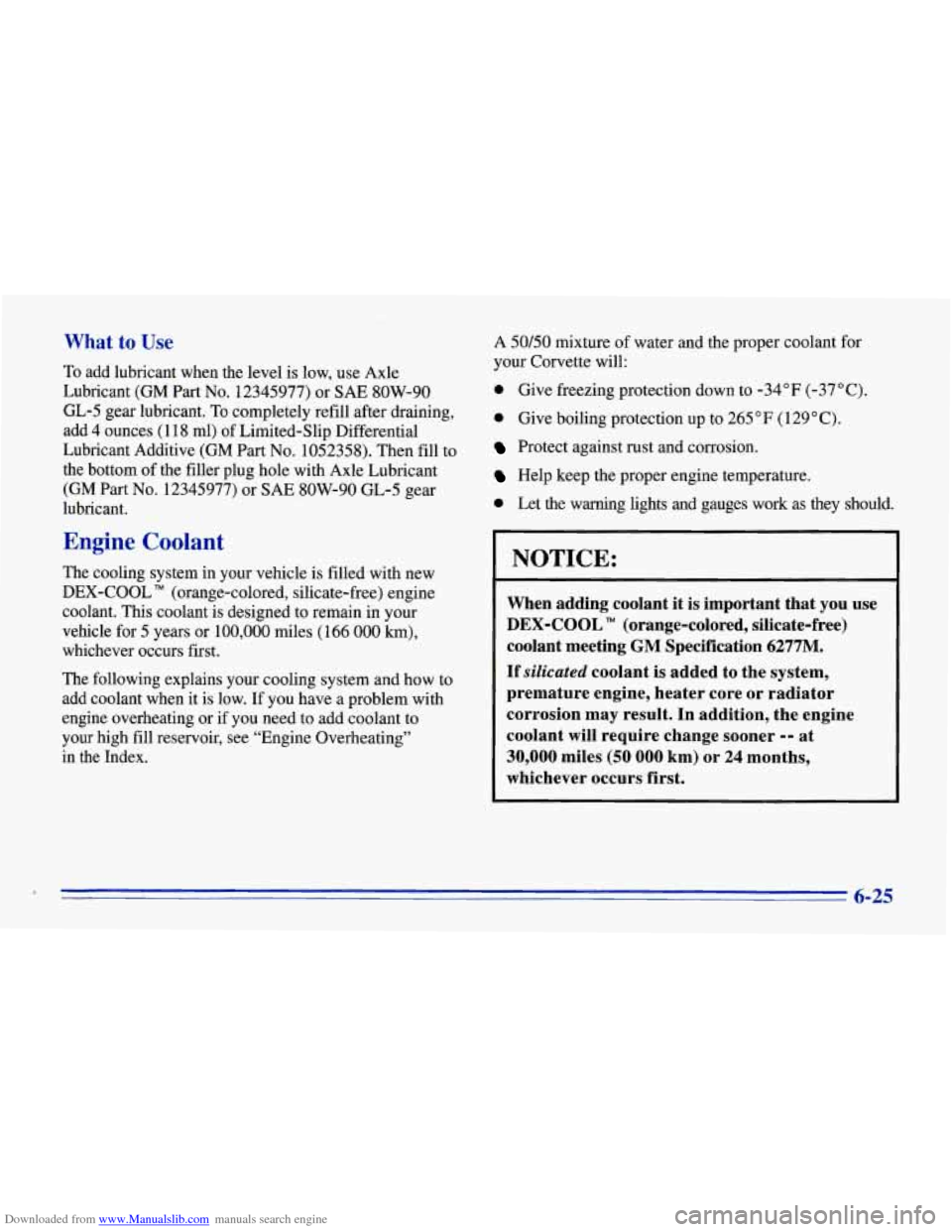Page 209 of 386

Downloaded from www.Manualslib.com manuals search engine You can be burned if you spill coolant on hot
engine parts. Coolant contains ethylene glycol
and it will burn
if the engine parts are hot
enough. Don’t spill coolant on a hot engine.
I
When the coolant in the coolant recovery tank is at or
above the
COLD mark, start your vehicle.
If the overheat warning continues, there’s one more
thing
you can try. You can add the proper coolant mix
directly
to the coolant high fill reservoir, but be sure the
cooling system is cool before
you do it.
Steam and scalding liquids from
a hot cooling
system can blow out and burn you badly. They are
under pressure, and if you turn the coolant high
fill reservoir pressure
cap -- even a little -- they
CAUTION: (Continued) can
come out
at high speed. Never turn the cap
when the cooling system, including the coolant
high fill reservoir pressure cap,
is hot. Wait for the
cooling system and coolant high fill reservoir
pressure cap to cool
if you ever have to turn the
I pressure cap.
5-18
Page 210 of 386
Downloaded from www.Manualslib.com manuals search engine How to Add Coolant to the C
Fill Reservoir mt
H
I NOTICE:
Your engine has a specific coolant high fill
reservoir
fill procedure. Failure to follow this
procedure could cause your engine
to overheat
and be severely damaged.
1. You can remove the coolant high fill reservoir
pressure cap when the cooling system, including the
coolant high
fill reservoir pressure cap and upper
radiator hose, is no longer hot. Turn the pressure cap
slowly counterclockwise
until it first stops. (Don’t
press down while turning
the pressure cap.)
If you hear a hiss, wait for that to stop. A hiss means
there is still some pressure left.
2. Then keep turning the pressure cap, but now push
down
as you turn it. Remove the pressure cap.
5-19
Page 211 of 386
Downloaded from www.Manualslib.com manuals search engine You can be burned if you spill coolant on hot
engine parts. Coolant contains ethylene glycol,
and it will burn if the engine parts are hot
enough. Don’t spill coolant on a hot engine.
I
3. After the engine cools, open the air bleed valve on
the water pump inlet.
4. Fill with the proper mix. Add coolant until you see
a steady stream
of coolant coming from the
bleed valve.
5. Close the bleed valve.
6. Continue to fill the coolant high fill reservoir up to
the base
of the filler neck.
7. Rinse or wipe the spilled coolant from the engine
compartment.
5-20
Page 212 of 386
Downloaded from www.Manualslib.com manuals search engine 8. Start the engine and allow it to idle for approximately
four minutes. By
this time, the coolant level inside the
coolant high fill reservoir will be lower. Add more of
the proper mix through the filler neck until the level
reaches the base of the filler neck.
I
9. Shut the engine off and replace the pressure cap. Be
sure the arrows on the cap line up like this.
10. Then fill the coolant recovery tank to the proper level.
For a complete drain, flush and refill, see your Chevrolet
dealer or
a Chevrolet Corvette Service Manual. To
purchase a service manual, see “Service and Owner
Publications’’ in
the Index.
5-21
Page 239 of 386
Downloaded from www.Manualslib.com manuals search engine LT1 Engine Shown, LT4 Engine Similar You’ll
see the following when you open the hood with
the
LT1 engine:
A. Hydraulic Clutch Fluid Reservoir
(if equipped)
B. Brake Fluid Reservoir
C. Battery
D. Electric Engine Fan
E. Air Cleaner
E Coolant Recovery Tank
G. Power Steering Fluid Reservoir
H. Engine Oil Fill Cap
I. Engine Oil Dipstick
J. Coolant High Fill Reservoir
K. Automatic Transmission Dipstick (if equipped)
L. Windshield Washer Fluid Reservoir
6-8
Page 240 of 386
Downloaded from www.Manualslib.com manuals search engine I
An electric fan under the hood can start up and
injure you even when the engine is not running.
Keep hands, clothing and tools away from any
underhood electric fan.
Things that burn can get on hot engine parts and
start a fire. These include liquids like gasoline,
oil, coolant, brake fluid, windshield washer and
other fluids, and plastic or rubber. You or others
could be burned. Be careful not to drop or spill
things that will burn onto
a hot engine.
Before closing the hood, be sure all the filler caps are
on.
Then release the hood strut by moving it to the centered
position and lowering the hood. Lower the hood until
the bottom
of the hood is the same height as the top
of the windshield, then release it.
6-9
Page 241 of 386
Downloaded from www.Manualslib.com manuals search engine Engine Oil
It’s a good idea to check your engine oil level every time
you get fuel. In order to get an accurate reading, the oil
must be warm and the vehicle must be on level ground.
The engine oil dipstick is
next to the coolant high fill
reservoir. The dipstick
handle is a round, yellow
loop.
Turn
off the engine and give the oil a few minutes to
drain back into the oil pan. If you don’t, the oil dipstick
might not show the actual level.
Checking Engine Oil
Pull out the dipstick and clean it with a paper towel or a
cloth, then push it back in all the way. Remove it again,
keeping the tip down.
6-10
Page 256 of 386

Downloaded from www.Manualslib.com manuals search engine What to Use
To add lubricant when the level is low, use Axle
Lubricant (GM
Part No. 12345977) or SAE SOW-90
GL-5 gear lubricant.
To completely refill after draining,
add 4 ounces
(1 18 ml) of Limited-Slip Differential
Lubricant Additive (GM Part
No. 1052358). Then fill to
the bottom
of the filler plug hole with Axle Lubricant
(GM
Part No. 12345977) or SAE SOW-90 GL-5 gear
lubricant.
Engine Coolant
The cooling system in your vehicle is filled with new
DEX-COOL (orange-colored, silicate-free) engine
coolant. This coolant is designed
to remain in your
vehicle for
5 years or 100,000 miles (166 000 km),
whichever occurs first.
The following explains your cooling system and how
to
add coolant when it is low. If you have a problem with
engine overheating or
if you need to add coolant to
your high fill reservoir, see “Engine Overheating”
in the Index.
A 50/50 mixture of water and the proper coolant for
your Corvette will:
0 Give freezing protection down to -34°F (-37°C).
0 Give boiling protection up to 265 OF ( 129 O C).
Protect against rust and corrosion.
Help keep the proper engine temperature.
0 Let the warning lights and gauges work as they should.
NOTICE:
When adding coolant it is important that you use
DEX-COOL (orange-colored, silicate-free)
coolant meeting GM Specification 6277M.
If
silicated coolant is added to the system,
premature engine, heater core or radiator
corrosion may result. In addition, the engine
coolant will require change sooner
-- at
30,000 miles (50 000 km) or 24 months,
whichever occurs first.
6-25